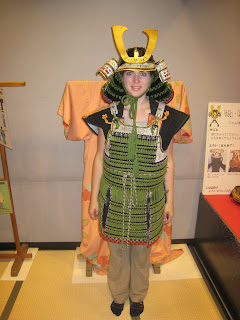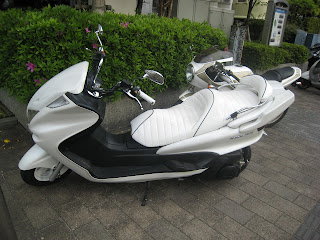 We arrived at our Ryoken, which is a Japanese Inn or Guesthouse. We were greeted by a tiny old lady who pulled out a laminated piece of paper with English written on it and a Japanese translation. She rapidly spoke in Japanese while pointing to each line of English. Apparently the lady of the house was out and she was to look after us in the meantime. She was hilarious, bustling around and asking us questions in Japanese. We think the word she kept using to ask if we understood was something like 'ne?' Loren was following what she was pointing to in English and replying 'Hai'(yes/ok). So there was a lot of pointing and then 'ne?', 'hai', 'ne?', 'hai'.
We arrived at our Ryoken, which is a Japanese Inn or Guesthouse. We were greeted by a tiny old lady who pulled out a laminated piece of paper with English written on it and a Japanese translation. She rapidly spoke in Japanese while pointing to each line of English. Apparently the lady of the house was out and she was to look after us in the meantime. She was hilarious, bustling around and asking us questions in Japanese. We think the word she kept using to ask if we understood was something like 'ne?' Loren was following what she was pointing to in English and replying 'Hai'(yes/ok). So there was a lot of pointing and then 'ne?', 'hai', 'ne?', 'hai'. We were thrilled to discover that the room was very traditional. The beds were thin mattresses with sheets and quilts on them, but they were just folded in half at the side of the room while no-one was using them. We were also each given a yukata, which is like a bathrobe that can be used as pajamas.
We were thrilled to discover that the room was very traditional. The beds were thin mattresses with sheets and quilts on them, but they were just folded in half at the side of the room while no-one was using them. We were also each given a yukata, which is like a bathrobe that can be used as pajamas.Hiroshima Peace Memorial Park
After settling in, we set off to see Hiroshima on foot, as the city is not very big. Our first stop was the Hiroshima Peace Memorial Park. We spent about 2 hours exploring the museum and learning all the details about the nuclear attack.
The fateful day of the attack was the 6th August, 1945, at 8.15am. 90,000 people died in the explosion and after 1945, the number reached 150,000. 92% of the buildings in a 2km radius were destroyed completely. The temperature of the hypocentre of the fire ball was 4000 degrees celsius.
The museum stocked all sorts of confidential documents from America that gave reasons for why the bomb was dropped. Some of the reasons were, that they wanted to finish WWII, or that they wanted to justify the 2 billion dollars that they'd spent on nuclear research for the A-bomb.
Other more sinister reasons include the desire to just see what a nuclear bomb would do.
They'd tested the bombs on deserted buildings and occasionally on animals tied to stakes, but they'd never seen what it would do to humans, and what it would do to an entire city. They even dropped scientific guages with the bomb, as though it was a sort of experiment. The choice of Japan as a possible nuclear target, as opposed to other possible countries such as the Soviet Union, was because they weren't scientifically advanced enough at that point to be able to make any use of the remains of the bomb, in terms of Japan trying nuclear research of their own.
 The damage to the city and the long term damage to those exposed to radiation was enormous. Many people died from diseases caused by the radiation, and other lived with strange mutilations to their bodies. One of many cases was a man who had fingernails that grew with blood vessels inside of them, so his nails were completely black. If the nails broke, they would bleed for a very long time, so he couldn't cut the nails at all. Models of humans with melted skin hanging off their arms were very disturbing, as were photographs of children and adults with burns covering their entire bodies. Many of the casualties were children that had been taken out of school to work on creating bomb shelter sites.
The damage to the city and the long term damage to those exposed to radiation was enormous. Many people died from diseases caused by the radiation, and other lived with strange mutilations to their bodies. One of many cases was a man who had fingernails that grew with blood vessels inside of them, so his nails were completely black. If the nails broke, they would bleed for a very long time, so he couldn't cut the nails at all. Models of humans with melted skin hanging off their arms were very disturbing, as were photographs of children and adults with burns covering their entire bodies. Many of the casualties were children that had been taken out of school to work on creating bomb shelter sites. We also saw pieces of concrete and steps that were stained black from the people that were burned and vaporised right in front of them. These sections were removed from the city and preserved.
We also saw pieces of concrete and steps that were stained black from the people that were burned and vaporised right in front of them. These sections were removed from the city and preserved.It was a shocking experience to learn what had happened to Japan, and to see how much Japan has recovered in the last 60 years. We were very encouraged by the way Japan has chosen to respond to the attack. They have chosen to use the devastation as an example to others countries of why nuclear disarmament is so important.
 There is a flame built into the monument in the peace memorial park, and it will not be put out until the last country is disarmed of its nuclear warheads. The mayor of Hiroshima writes a letter every month to the head of the nuclear governing body in America, begging them to give up their weapons and promote peace.
There is a flame built into the monument in the peace memorial park, and it will not be put out until the last country is disarmed of its nuclear warheads. The mayor of Hiroshima writes a letter every month to the head of the nuclear governing body in America, begging them to give up their weapons and promote peace. After visiting the museum, we wandered through the memorial park and saw the flame, and an old building made of ferro-concrete whose skeleton survived the bomb. The remains of the building are left standing as a reminder of what Hiroshima has endured.
After visiting the museum, we wandered through the memorial park and saw the flame, and an old building made of ferro-concrete whose skeleton survived the bomb. The remains of the building are left standing as a reminder of what Hiroshima has endured.Hiroshima-jo Castle
 We then headed for Hiroshinma-jo (Carp Castle) which was constructed in 1589. Much of it was dismantled after the Mejii restoration, leaving only Donjon main gates. The rest was destroyed by the bomb, but was rebuilt in modern reinforced concrete in 1958.
We then headed for Hiroshinma-jo (Carp Castle) which was constructed in 1589. Much of it was dismantled after the Mejii restoration, leaving only Donjon main gates. The rest was destroyed by the bomb, but was rebuilt in modern reinforced concrete in 1958.
 The inside of the castle had displays about the history of Hiroshima, but it was all in Japanese. We had fun trying on some outfits there though. Artur tried on the traditional male 'kimono', and Loren tried on the Samurai armour, because the girl's kimono was missing several pieces.
The inside of the castle had displays about the history of Hiroshima, but it was all in Japanese. We had fun trying on some outfits there though. Artur tried on the traditional male 'kimono', and Loren tried on the Samurai armour, because the girl's kimono was missing several pieces.
At the top of the castle, you could see all around the city of Hiroshima. The view was great from the balconies.
Japanese Southbank
 We had dinner by the river, and once again we were surprised by how much the area looked like Melbourne. The place where we ate looked just like the new set of restaurants by the river near Federation Square.
We had dinner by the river, and once again we were surprised by how much the area looked like Melbourne. The place where we ate looked just like the new set of restaurants by the river near Federation Square. Artur kept stopping all the way throughout Hiroshima, because he was fascinated by the large scooters. He kept taking photos of the different models, including Majesty, Skyward and Fission.
Artur kept stopping all the way throughout Hiroshima, because he was fascinated by the large scooters. He kept taking photos of the different models, including Majesty, Skyward and Fission.



2 comments:
Hey guys, it´s Jed. This looks great, all the food and clothes! And the peace park. I really want to visit that. It must be such an experience though I´ve heard they say basically nothing about Japan´s actions during the war and that many Japanese believe it was an unprovoked attack. I mean I know the US had already basically destroyed Japan with firebombing and could have easily won in the Pacific without the nuclear bomb, but with all of Japan´s actions, including attacking Australia and their actions in China, you´d think this would be worth a mention... but as I say, I don´t know what it´s like there... did you have any thoughts on that from your experience there???
Hey Jed!
Just found this comment after I saw the other one :)
Yeah, I know what you mean. The attack was not unprovoked, obviously they'd involved themselves in the war, and therefore opened themselves up to possible defeat.
I just had the strongest impressions from seeing the confidential documents from America. They explicitly said that in writing a peace treaty with Japan, they would insert conditions that they knew Japan would never agree to. This would force Japan to reject the peace treaty, make America look like they tried to solve the war peacefully, and then look justified in testing their nuclear bomb.
'Attack' was not unprovoked, but I don't think 'nuclear attack' is ever justified.
Catch up with you soon,
Loren
Post a Comment